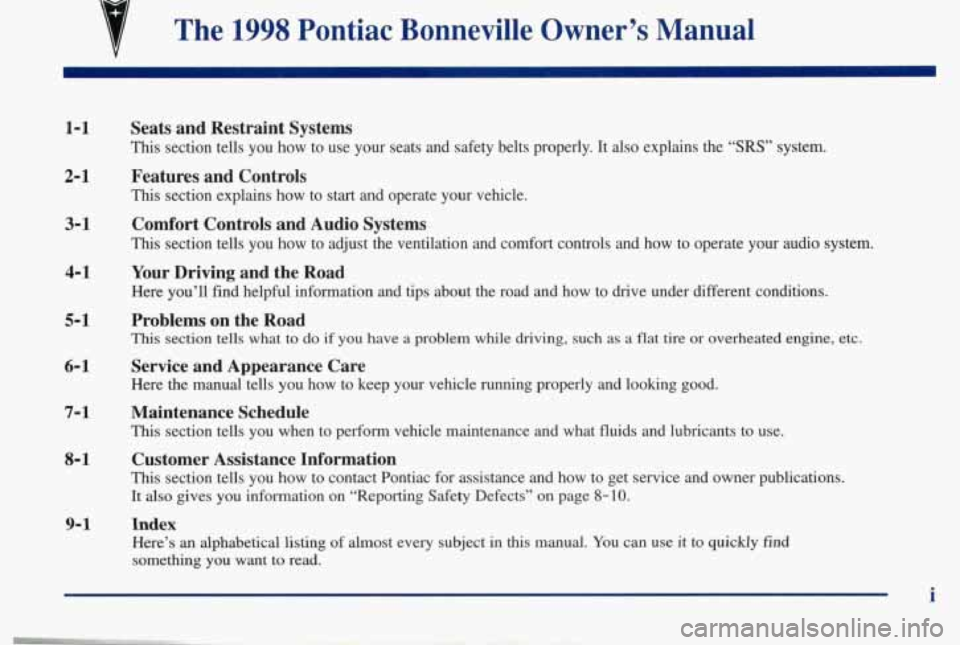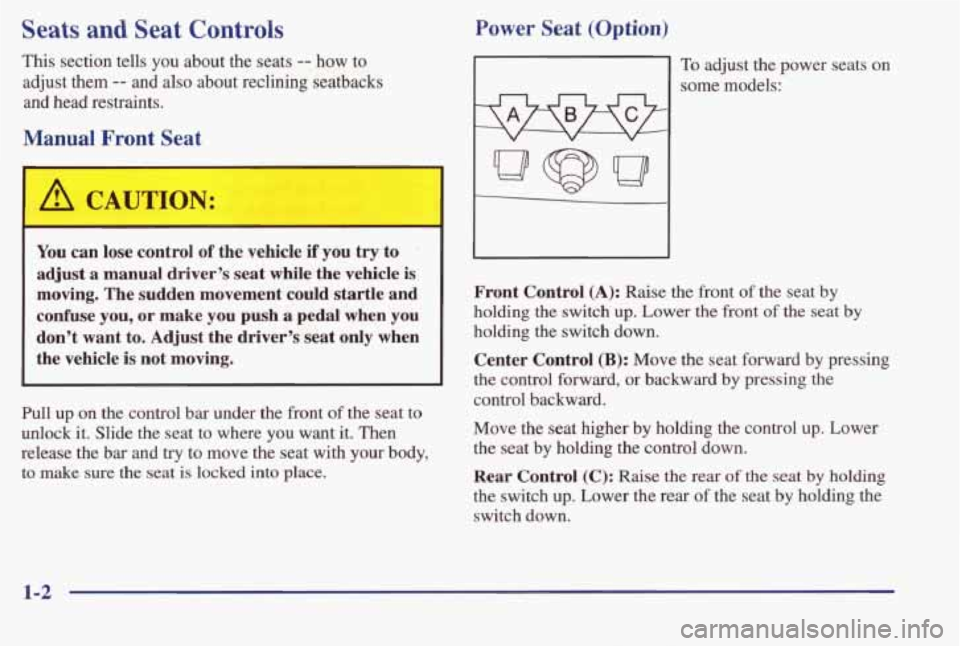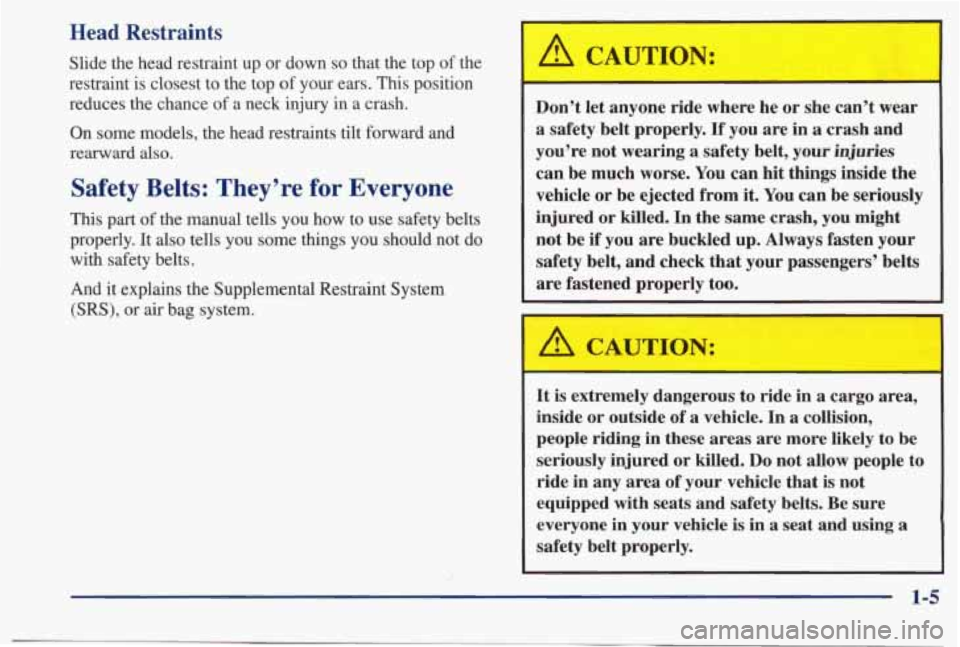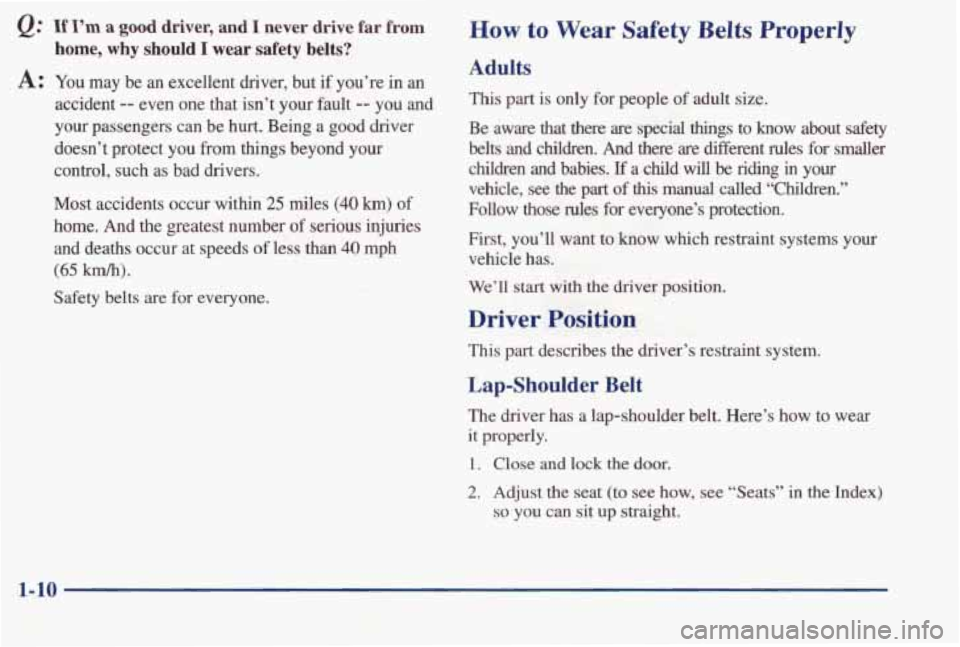Page 2 of 395

B
v
The 1998 Pontiac Bonneville Owner’s Manual
1-1
2-1
3-1
4-1
5- 1
6-1
7- 1
8- 1
Seats and Restraint Systems
This section tells you how to use your seats and safety belts prop\
erly. It also explains the “SRS” system.
Features and Controls
This section explains how to start and operate your vehicle.
Comfort Controls and Audio Systems
This section tells you how to adjust the ventilation and comfort co\
ntrols and how to operate your audio system.
Your Driving and the Road
Here you’ll find helpful information and tips about the road\
and how to drive under different conditions.
Problems on the Road
This section tells what to do if you have a problem while driving, such as a flat tire or overheated engine, etc.
Service and Appearance Care
Here the manual tells you how to keep your vehicle running properly and looking good.
Maintenance Schedule
This section tells you when to perform vehicle maintenance and what \
fluids and lubricants to use.
Customer Assistance Information
This section tells you how to contact Pontiac for assistance a\
nd how to get service and owner publications.
It also gives you information
on “Reporting Safety Defects” on page 8-10.
9-1 Index
Here’s an alphabetical listing of almost every subject in this manual. You can use it to quickly find
something you want
to read.
i
Page 8 of 395
I
Section 1 Seats and Restraint Systems
Here you’ll find information about the seats in your Pontiac\
and how to use your safety belts properly. You can also
learn about some things you should
not do with air bags and safety belts.
1-2
1-5
1-9 Seats and Seat Controls
Safety Belts: They’re for Everyone
Here Are Questions Many People Ask About
Safety Belts
-- and the Answers
1-10 How to Wear Safety Belts Properly
1-10 Driver Position
1 - 17 Safety Belt Use During Pregnancy
1 - 18 Right Front Passenger Position
1 - 18 Supplemental Restraint System (SRS)
1-24 Center Passenger Position
1-26
1-29
1-31
1-34
1-46
1-49
1-49 1-49 Rear Seat Passengers
Rear Safety Belt
Comfort Guides for Children
and Small Adults
Children
Child Restraints
Larger Children
Safety Belt Extender
Checking Your Restraint Systems
Replacing Restraint System Parts
After
a Crash
Page 9 of 395

Seats and Seat Controls
This section tells you about the seats -- how to
adjust them
-- and also about reclining seatbacks
and head restraints.
Manual Front Seat
A CAUTION:
You can lose control of the vehicle if you try to
adjust a manual driver’s seat while the vehicle is
moving. The sudden movement could startle and
confuse
you, or make you push a pedal when you
don’t want to. Adjust the driver’s seat
only when
the vehicle
is not moving.
Pull
up on the control bar under the front of the seat to
unlock it. Slide the seat to where you want it. Then
release the bar and
try to move the seat with your body,
to make sure the seat is locked into place.
Power Seat (Option)
To adjust the power seats on
some models:
Front Control
(A): Raise the front of the seat by
holding the switch up. Lower the front of the seat by
holding the switch down.
Center Control
(B): Move the seat forward by pressing
the control forward, or backward by pressing the
control backward.
Move the seat higher by holding the control up. Lower
the seat by holding the control down.
Rear Control (C): Raise the rear
of the seat by holding
the switch up. Lower the rear of the seat by holding the
switch down.
1-2
Page 12 of 395

Head Restraints
Slide the head restraint up or down so that the top of the
restraint is closest to the top
of your ears. This position
reduces the chance
of a neck injury in a crash.
On some models, the head restraints tilt forward and rearward also.
Safety Belts: They’re for Everyone
This part of the manual tells you how to use safety belts
properly. It
also tells you some things you should not do
with safety belts.
And it explains the Supplemental Restraint System
(SRS), or air bag system.
A CAUTION:
Don’t let anyone ride where he or she can’t wear
a safety belt properly.
If you are in a crash and
you’re not wearing a safety belt, your
injuries
can be much worse. You can hit things inside the
vehicle or be ejected from it.
You can be seriously
injured or killed. In the same crash, you might
not be if you are buckled up. Always fasten your
safety belt, and check that your passengers’ belts
are fastened properly too.
- I
A CAUTION:
It is extremely dangerous to ride in a cargo area,
inside or outside of a vehicle.
In a collision,
people riding in these areas are more likely to be
seriously injured or killed. Do not allow people
to
ride in any area of your vehicle that is not
equipped
with seats and safety belts. Be sure
everyone in
your vehicle is in a seat and using a
safety belt properly.
1-5
Page 17 of 395

Q: If I’m a good driver, and I never drive far from
home, why should I wear safety belts?
A: You may be an excellent driver, but if you’re in an
accident -- even one that isn’t your fault -- you and
your passengers can be hurt. Being a good driver
doesn’t protect you from things beyond
your
control, such as bad drivers.
Most accidents occur within
25 miles (40 km) of
home. And the greatest number
of serious injuries
and deaths occur at speeds
of less than 40 mph
(65 km/h).
Safety belts are for everyone.
How to Wear Safety Belts Properly
Adults
This part is only for people of adult size.
Be aware that there are special things to know about safety
belts and children. And there are different rules for smaller
children and babies.
If a child will be riding in your
vehicle, see the part of this mand called “Children.”
Follow those rules for everyone’s protection.
First, you’ll want to know which restraint systems your
vehicle has.
We’ll start with the driver position.
Driver Position
This part describes the driver’s restraint system.
Lap-Shoulder Belt
The driver has a lap-shoulder belt. Here’s how to wear
it properly.
1. Close and lock the door.
2. Adjust the seat (to see how, see “Seats” in the Index)
so you can sit up straight.
1-10 - .
Page 32 of 395
Lap Belt
If your vehicle has front and rear bench seats, someone
can sit in the center positions.
When you sit in
a center seating position, you have a lap
safety belt, which has no retractor.
To make the belt
longer, tilt the latch plate and pull it along the belt.
To make the belt shorter, pull its free end as shown until
the belt is snug.
Buckle, position and release it the same way as the lap
part of a lap-shoulder belt. If the belt isn’t long enough,
see “Safety Belt Extender” at the end of this section.
Make sure the release button on the buckle is positioned
so you would be able to unbuckle the safety belt quickly
if you ever had to.
Page 42 of 395
A rear-facing infant restraint (B) positions an infant
to face the rear
of the vehicle. Rear-facing infant
restraints are designed
for infants of up to about
20 lbs. (9 kg) and about one year of age. This type
of restraint faces the rear
so that the infant’s head,
neck
and body can have the support they need in a
crash. Some infant seats come in two parts -- the
base stays secured in the vehicle and the seat part
is removable.
1-35
Page 44 of 395
A booster seat (F, G) is designed for children who
are about 40 to 60 lbs. (18 to 27 kg) and about four
to eight years of age. It’s designed to improve the
fit of the vehicle’s safety belt system. Booster seats
with shields use lap-only belts; however, booster
seats without shields use lap-shoulder belts.
Booster seats can
also help a child to see out
the window.
1-37